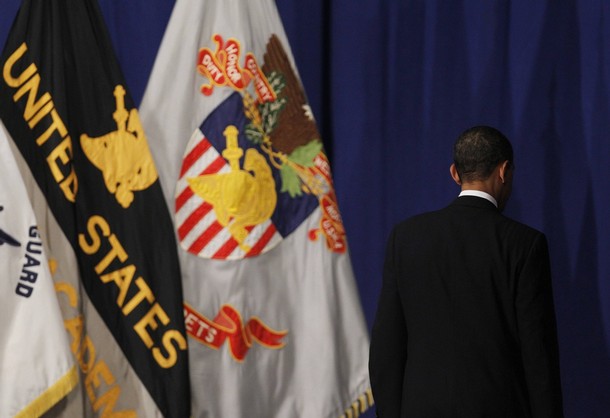
After months of careful consideration, President Obama announced his newest Afghanistan policy last night. He will send an additional 30,000 troops in rapid fashion — giving General McChrystal most of what he asked for — but also announced an exit timetable that makes a successful counterinsurgency impossible.
Previewing the speech, Atlantic Council vice president and international security program director Damon Wilson said, "The president needs to disarm his critics, who have questioned his clarity, decisiveness, and resolve." The test of that, he explained, is "How does the president articulate his exit strategy? Does he set a hard timeline for withdrawal or does he take a developments-based approach, focusing on progress in meeting benchmarks?"
Looking at the text of the speech, we can see Obama tried to split the difference.
[A]s commander-in-chief, I have determined that it is in our vital national interest to send an additional 30,000 U.S. troops to Afghanistan.
After 18 months, our troops will begin to come home. These are the resources that we need to seize the initiative, while building the Afghan capacity that can allow for a responsible transition of our forces out of Afghanistan.
His rationale for this timetable?
We have been at war now for eight years, at enormous cost in lives and resources. Years of debate over Iraq and terrorism have left our unity on national security issues in tatters and created a highly polarized and partisan backdrop for this effort. And having just experienced the worst economic crisis since the Great Depression, the American people are understandably focused on rebuilding our economy and putting people to work here at home.
This is almost purely a domestic calculus. He’s right, of course, that the strain of the deployments in Iraq and Afghanistan have constrained our ability to deploy forces elsewhere and threatens to undermine the readiness of our military. Still, the exit strategy is decidedly not based on "success" — however it might be defined — in Afghanistan.
The president has, after a few months of seeming to back a counterinsurgency approach to AfPak, narrowed his focus back to the counterterrorism policy he announced toward the beginning of his term.
Our overarching goal remains the same: to disrupt, dismantle and defeat al-Qaeda in Afghanistan and Pakistan and to prevent its capacity to threaten America and our allies in the future.
To meet that goal, we will pursue the following objectives within Afghanistan. We must deny al-Qaeda a safe haven. We must reverse the Taliban’s momentum and deny it the ability to overthrow the government. And we must strengthen the capacity of Afghanistan’s security forces and government, so that they can take lead responsibility for Afghanistan’s future.
[…]
The 30,000 additional troops that I’m announcing tonight will deploy in the first part of 2010, the fastest possible pace, so that they can target the insurgency and secure key population centers. They’ll increase our ability to train competent Afghan security forces and to partner with them so that more Afghans can get into the fight. And they will help create the conditions for the United States to transfer responsibility to the Afghans.
[…]
We’ll continue to advise and assist Afghanistan’s security forces to ensure that they can succeed over the long haul. But it will be clear to the Afghan government — and, more importantly, to the Afghan people — that they will ultimately be responsible for their own country.
This strategy is quite similar, of course, to the successful Surge in Iraq of 2007. The differences on the ground are enormous. More importantly, while the Surge always came with the understanding that it was temporary, there was never a stark calendar-based timetable attached to it.
The president addressed this criticism head-on:
[T]here are those who oppose identifying a timeframe for our transition to Afghan responsibility. Indeed, some call for a more dramatic and open-ended escalation of our war effort, one that would commit us to a nation-building project of up to a decade. I reject this course because it sets goals that are beyond what can be achieved at a reasonable cost and what we need to achieve to secure our interests.
Furthermore, the absence of a timeframe for transition would deny us any sense of urgency in working with the Afghan government. It must be clear that Afghans will have to take responsibility for their security and that America has no interest in fighting an endless war in Afghanistan.
The first of these points is unassailable. Indeed, Henry Kissinger pointed this out in his January lecture to the Atlantic Council, saying that our goals in Afghanistan exceeded our political willingness to sustain and that we therefore needed to align our strategy with what is actually possible.
But having a firm calendar-based timetable — especially a public one — signals that the president does not believe achieving the mission at hand is really as urgent as he claims. What if, come the middle of 2011, we have not defeated the Taliban? What if a sober assessment of the Afghan government and security forces reveals that they are not yet ready to carry out the struggle as the lead actors? Will we simply "advise and assist" and hope for the best?
The president doesn’t say.
Instead, the next twenty-five paragraphs of the speech are essentially a domestic policy address, the theme of which was "That’s why our troop commitment in Afghanistan cannot be open- ended: because the nation that I’m most interested in building is our own." That’s a welcome message to a domestic audience grown weary of war. But it’s not one likely to inspire much confidence in Afghans being asked to bet their lives on our strategy.
James Joyner is managing editor of the Atlantic Council. Photo: Reuters Pictures.
Image: obama-afghanistan-speech-exit.jpg
